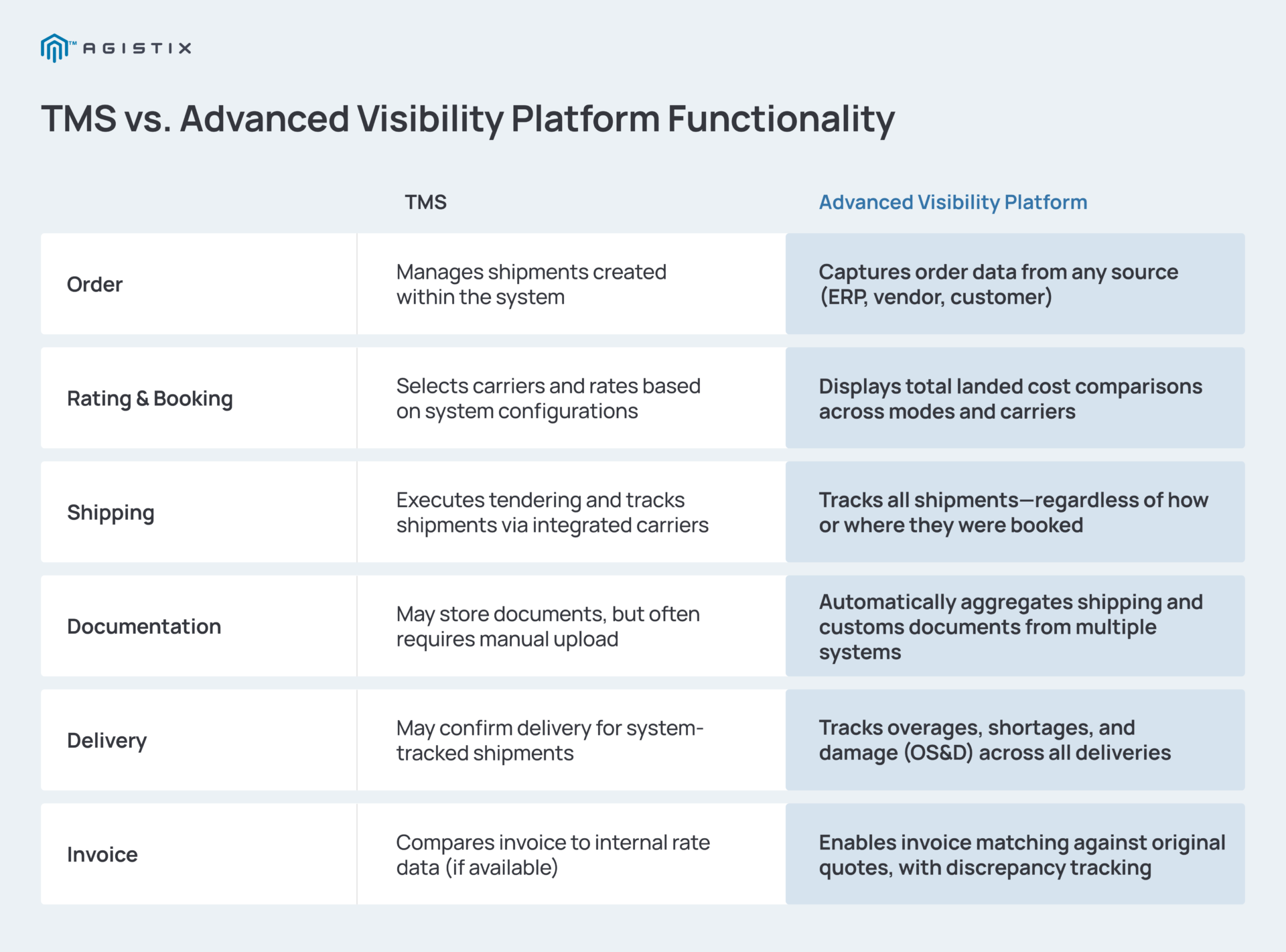July 17, 2025 - 6 minutes read

TMS vs. Visibility Platforms: Clarifying the Supply Chain Tech Stack
Visibility. It’s a word that gets used often in supply chain conversations, but it doesn’t always mean the same thing. Transportation management systems (TMS) and supply chain visibility platforms both handle logistics data, but their roles and the type of visibility they provide are fundamentally different. Confusing the two can result in critical blind spots across operations.
This article examines the core functions of each system, highlights where visibility gaps occur, and explains why distinguishing between them is essential for global supply chain performance.
Why TMS and Supply Chain Visibility Are Often Confused
TMSs and supply chain visibility platforms are rightfully grouped together under the umbrella of logistics technology. Both deal with shipment data, carrier communication, and performance tracking, so it’s easy to assume they serve a similar purpose. And because many TMS solutions claim to have built-in tracking features, companies may believe they already have sufficient visibility.
But too often, issues surface when operations become more complex, like when inbound freight is managed by suppliers, shipments involve a variety of stakeholders, or carrier invoices don’t match expected charges. These are the moments when “visibility” proves to mean different things depending on the tool in place. A TMS may show shipment status for loads created in the system, but it won’t capture activity happening elsewhere without manual effort.
For global shippers and multi-party environments, distinguishing between execution tools and true visibility platforms becomes critical. Without clarity on what each system actually provides, it’s easy to overlook operational blind spots and miss cost-saving opportunities.
What Does a TMS Do?
TMSs are designed to handle core transportation execution tasks. These systems are typically used to manage shipments booked directly by a company’s internal logistics team, supporting carrier selection, load tendering, and freight settlement within a defined operating environment. TMSs are well-suited for automating routine processes and ensuring compliance with pre-configured routing guides or service agreements.
Most TMS platforms support the following functions:
- Generate and manage shipments within the system
- Rate shop across approved carriers based on cost and service
- Tender loads and manage dispatch through carrier integrations
- Monitor shipment status via EDI/API-connected carriers
- Handle invoice processing and payment workflows
TMSs are generally effective for managing outbound freight or contracted carrier networks where the company fully controls the booking process. But when shipments are initiated by external partners or when visibility relies on data from outside systems, coverage becomes much harder.
Visibility Gaps in a TMS
While TMSs offer visibility into shipments executed within the system, that visibility rarely extends beyond it. Gaps are especially common in global, multi-party supply chains where data flows in from many different sources. Common limitations include:
- System Dependency: Visibility is typically limited to shipments created or manually entered in the TMS, excluding activity initiated outside the platform.
- Carrier Integrations: Only shipments with integrated carriers are tracked automatically—others often require manual updates or email follow-ups.
- Inbound Freight Blind Spots: Freight managed by suppliers or vendors often falls outside TMS coverage, leaving teams without insight into inbound timelines or delays.
- Document Access: Shipping documents and customs paperwork may not be centralized or automatically collected, especially for international shipments.
- Compliance & Exceptions: There’s limited visibility into customs clearance, regulatory holds, or delivery discrepancies like overages, shortages, and damage (OS&D).
Without centralized access to complete information, teams end up wasting time chasing updates across emails, portals, and spreadsheets, which slows down operations and increases risk.
What is Supply Chain Visibility Software?
Modern supply chains generate an enormous amount of data, and supply chain visibility software is designed to consolidate that information, providing actionable insights across orders, shipments, documentation, and financials. But not all visibility platforms offer the same scope or depth. The most effective solutions do more than simple location tracking—they connect data across the shipment lifecycle, enabling better decisions and faster resolutions.
Defining Supply Chain Visibility
While “visibility” is a common term in logistics, it’s often defined too narrowly. Many solutions focus on in-transit tracking—monitoring where a shipment is and when it’s expected to arrive. But true visibility needs to go further to monitor purchase order status, fulfillment activity, SKU-level detail, carrier performance, and exceptions in real time.
Achieving that level of insight requires centralizing data from multiple sources, including TMS, ERP, carrier portals, freight forwarder systems, and even individual email threads. When platforms only surface partial data, teams are left stitching together the rest manually. A strong visibility solution connects the dots across systems to reveal the full story behind every transaction.
A Broader View: From Order to Invoice
To deliver meaningful supply chain visibility, a platform must connect every stage of the shipment lifecycle. Each phase provides critical context that supports more informed decisions across logistics, operations, and finance teams.
- Order: Surfaces fulfillment schedules and planned ship dates, along with projected ETAs, allowing teams to plan around lead times and inventory needs.
- Rating & Booking: Captures cost and service-level comparisons, making it easier to evaluate routing options and select the best-fit carrier based on real-time conditions.
- Shipping: Monitors in-transit status and exceptions, while also tracking required documentation such as bills of lading, customs forms, or proof of delivery.
- Delivery: Confirms delivery status and flags OS&D, providing early visibility into downstream disruptions or disputes.
- Invoice: Compares final charges against quoted or expected rates, helping identify discrepancies and reduce invoice errors before they hit accounting.
When platforms connect data across all touchpoints, visibility effectively supports coordinated, cross-functional decision-making.
TMS vs. Advanced Visibility Platform Functionality
TMS platforms and visibility solutions are often assumed to offer overlapping capabilities, but there are significant differences in their functions across the shipment lifecycle. TMSs are typically built for transportation execution within a defined environment. That means visibility is usually limited to what’s happening inside the system, like shipments created by internal teams, tracked through integrated carriers, and supported by carrier data alone. While effective for managing contracted outbound freight, TMSs generally lack the ability to surface information from external sources or provide the context behind delays, exceptions, or service failures. They work well in contained use cases but tend to fall short when coordination extends beyond internal systems and teams.
Modern visibility platforms, by contrast, aim to connect fragmented systems and all relevant stakeholders. They should provide transaction details from initial order and booking decisions to invoice verification, regardless of where the data originates. A robust platform should not only show where a shipment is, but go deeper to display when it was supposed to ship, what documentation is missing or incomplete, whether any OS&D issues occurred on arrival, and if invoices align with anticipated charges.

Enter Agistix: Unified TMS + True Visibility
Agistix combines shipment execution and supply chain visibility in a single platform, so teams don’t have to rely on multiple tools to manage logistics and monitor performance. Whether shipments are booked internally or by external partners, all data flows into a centralized system that makes it actionable and easy to manage.
The platform supports rating, booking, and tendering while also capturing updates across all modes. Key documents, such as purchase orders, commercial invoices, packing slips, and bills of lading, are stored and tracked alongside each shipment. Agistix also enables delivery verification, OS&D tracking, and invoice matching to help teams identify discrepancies and close the loop faster.
Agistix Microsites extend that visibility to suppliers, carriers, and customers. These customized portals provide instant access to shipment status, documentation, and alerts, pulled directly from the platform. Microsites eliminate the delays, back-and-forth emails, and miscommunications that come from relying on spreadsheets or siloed systems.
For companies looking to streamline logistics and gain end-to-end clarity, Agistix offers a unified solution. Contact us to learn more or request a personalized demo.
